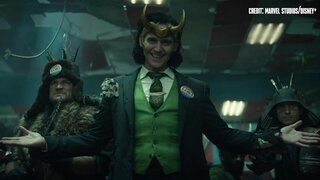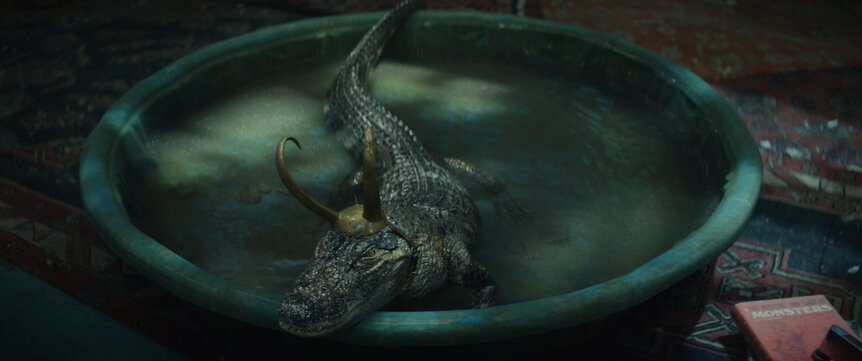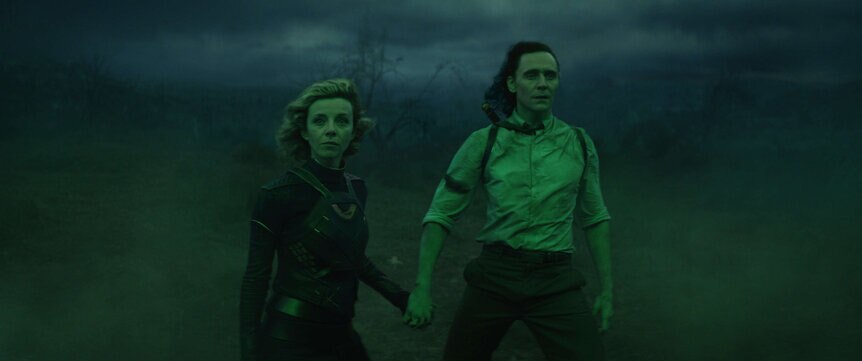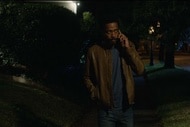Create a free profile to get unlimited access to exclusive videos, sweepstakes, and more!
From Sylvie's origin to gator physics: 7 things we learned from Disney+'s 'Loki' special

While Disney has yet to kick off production for Season 2 of Loki, die-hard fans of the show can still get their temporal fix this week by checking out the third episode of Marvel Studios' Assembled.
Running for just over an hour, the latest installment of the MCU docuseries offers up an entire Sacred Timeline's worth of fun tidbits about the god of mischief's first solo outing. Like the multiverse itself, the show's production held many unexpected and bizarre surprises. As we wait for all those bellicose Kangs to start an inter-dimensional war, head below for seven fun facts we learned from the special.
Condolences to Scott Bakula
When Marvel confirmed that Loki would feature the Time Variance Authority as a key plot point, fans started to compare the show to Doctor Who and Legends of Tomorrow. Head writer Michael Waldron really wanted to subvert those expectations and have the show stand as its own quantity.
"I think what a lot of people expected was, 'This is gonna be Quantum Leap. This is gonna be Loki riding with Paul Revere or influencing historical events,'" Waldron explains. "And my pitch from the first time I met with those guys was, 'Let's blow up what people think the show is.'"
Dune-ing it up at the TVA
We already know that iconic pieces of media like Mad Men, Blade Runner, and Toy Story (not even joking) were all creative influences on Loki. Until today, however, we had no idea that David Lynch's 1984 film adaptation of Dune had a major bearing on the TVA's etheral time doors.
In particular, the VFX team looked at the force field-style body armor used by Paul Atreides, Gurney Halleck, and Duncan Idaho. "We looked at probably a good 150 different designs before we landed on something that everyone really liked," reveals Additional VFX Supervisor Luke McDonald. If you think about, Arrakis does exist somewhere in the multiverse.
Sylvie's story
Loki's female variant, Sylvie (Sophia Di Martino), does exist in the comics, but the version of her that we meet in the show is actually a combination of two characters from the Marvel source material. The first is Sylvie Lushton, a woman from Oklohoma upon whom Loki bestowed magical powers and took on as his apprentice. The second is Echantress, aka Amora, a powerful Asgardian sorceress.
"What really intrigued me about the story was that this was a female variant of Loki, who is a lot more in line with the Enchantress character that we know from the comics," says series director Kate Herron. "But also, in a sense, [she's] a complete reimagining of the Enchantress and I thought there was something very interesting in taking these two identities of Loki, but doing something a little bit different."
Richard E. Grant or bust
While only in one full episode, Richard E. Grant's portrayal of what one might call "Classic Loki" was definitely a standout for audiences. He was absolutely perfect...almost as if the role was written just for him. And it was. Tom Hiddleston admits that there was no one else considered for the part. In fact, Grant's face was drawn into all of the concept art for that particular variant.
Gator physics
There's a very good reason why Alligator Loki was such a smash hit with viewers: the production worked incredibly hard to strike the perfect balance between natural movement and wily cunning. Herron asked for a gator that was "very handsome and had beautiful eyes," and the VFX team magnificently rose to the occasion.
"Alligator Loki was a very unique character because of the fact that sometimes, the physics of a real alligator are not taken into consideration," McDonald says. "Things like picking him up, for instance. Well, picking up an alligator is a very, very strange thing because alligators' spines only bend a certain way."
Working closely with the folks at ILM, the Loki team worked off a piece of reference material from a real-world support alligator by the name of Wally. "It can't just be an alligator ... We really wanted to give that cheeky Loki grin or that mischievous look to him," McDonald continues. "So, we based our alligator off of as much reality as we possibly could."
Alioth erupts
The Void's attack dog — a ravenous being that gobbles up all the TVA's pruned rubbish — may be inspired by the entity in the comics, but its ultimate design was derived from nature.
"Nature can be terrifying," says Herron, who wanted to tease out Alioth like Steven Spielberg did with the man-eating shark in Jaws. Leaning into the idea of the natural world's more destructive tendencies, McDonald immediately Googled up images of "volcanic eruptions and pyroclastic flows and absolutely beautiful thermal lightning within these pyroclastic flows."
He Who Remains is not Kang...not exactly
This one's already been picked over pretty thoroughly. Even Herron has said that He Who Remains (Jonathan Majors) was more inspired by Immortus than he was by Kang. That said, the character we meet in the Season 1 finale still is a variant of the temporal conquerer, who will now seize on the chance to subjugate all of the multiverse under his purple thumb.
Episode 3 of Assembled puts the speculation to rest when Tom Hiddleston states the following: "The variant of He Who Remains, the one he's been talking about, the one that he's so afraid of, is Kang. Kang is bent on destruction and I'm so curious to see what Jonathan [Majors] does in the future."
"That was the thing that grabbed me and pulled me into the role," adds Majors. "The fact that Kang lives in so many iterations. As He Who Remains says, 'Reincarnation, baby.'"
All six episodes of Loki's debut season are now available to stream on Disney+.


































